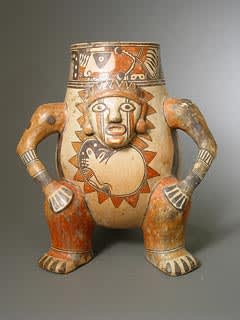Tlaloc Effigy Vessel, 1100 CE - 1500 CE
Terracotta
14.75
PF.4156
Further images
White slipped pottery first appeared c.800 A.D. and continued until the Spanish conquest. With this change came new themes of pictorial imagery and a new appearance in the art of...
White slipped pottery first appeared c.800 A.D. and continued until the Spanish conquest. With this change came new themes of pictorial imagery and a new appearance in the art of ceramics. At some point artists began applying heavy coats of white as a background foundation. This served to highlight symbols and designs in a spectacular way, making the reading of a vessel easier and more dramatic. In the absence of a written language, art was a way of communicating ideas to people of similar cultural backgrounds. During these periods three central themes appeared- Man/Jaguar; Plumed Serpent; and Effigy face. The figure on this stunning vessel seems to belong to this last category. The face itself is reminiscent of Tlaloc or Rain-God of Central Mexico; and given further representation by making the vessel like a seated man, with feet and hands done in a delightful, almost playful, abstract manner. Another interesting aspect is a panel or band on the upper portion showing the profiles of two identical figures. Each wears an elaborate headdress with a triangle in black painted around the eye. This probably depicts a shaman who is warily watching out for spirits or signs in the heavens. There is a feeling that the central figure in particular and the vessel as a whole, is offering protection to whoever is its owner. It is generally assumed women were pottery makers, and it is fascinating to detect a feminine touch in the beautifully worked clay.





